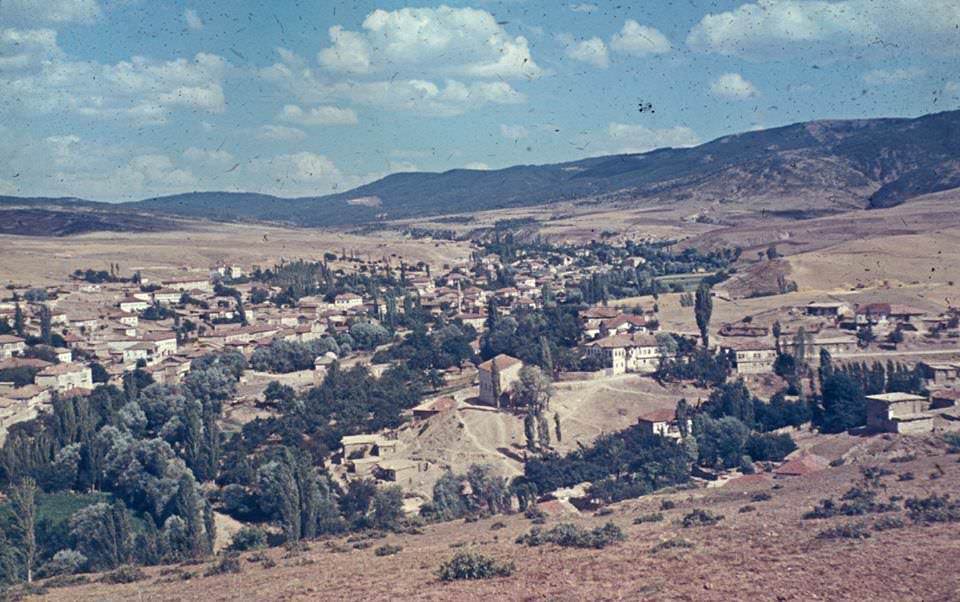
Administration
The village Akdağmadeni was elevated to Kaza Merkezi (county center) in 1871 and thus became a city.
Toponym
Both the Greek (Ἀργυρίων – Argyríōn) and the present Turkish place name refer to the mining history of the region.
Population
The district Akdağmadeni belonged to the Greek Orthodox Metropolis of Chaldea. The population of the administrative seat Akdağmadeni prior to 1923 was made up of 8,000 people, 5,000 of whom were Greek.[1]
“The 3,361 Armenians from Akdağmaden lived mainly in Akdağ, the seat of the kaza (pop. 1,300), Delihamza (pop. 250), and Karaçayer (pop. 300).”[2] They possessed three churches and six schools with an enrolment of 450 pupils.[3]
While the town had 1,250 inhabitants in 1923, the population decreased considerably after the forced resettlement of Greeks and Armenians to Greece in 1924-1927. At the same time, 266 muhacir families from Greece were settled in Akdağmadeni from the Kayalar region near Thessaloniki, but since some of them migrated to other areas, the population shortage could not be compensated for many years. Since many resettlers were tobacco farmers, they had again migrated to their found relatives in the Turkish tobacco zones.
The Greek villages of Άκνταγ–Μαντέν – Akdağmadeni
Άκνταγ-Μαντέν- Akdağmadeni
Ακτάς – Aktaş
Αλμαλίκιολου – Almalikiolou
Απτουραχμανλού – Aptourakhmanlou
Γεντίσερ – Yentiser
Γουλούπουαρ – Youloupouar
Γούρτινι – Yourtini
Γουσλάδες (Τάλαν, Ιγταλί, Αβραμάντων, Γανταμίρ ή Παυλάντων) – Youslathes (Talan, Igtali, Avramanton, Gantamir or Pavlanton)
Εβτζί – Evtzi
Καραπίρ – Karapir
Καράτζορεν – Karatzoren
Κατίκισλα – Katikisla
Κέισερι – Keiseri (Kayseri)
Κουλόυκ – Koulouk
Κούσκαγια – Kouskayia
Ολούτζα – Oloutza
Ούτσκαγιασί – Outskayiassi
Πατσατάχ – Patsatakh
Παχτσετσίκ – Pakhtsetsik
Ποσκιούκ – Poskiouk
Σαχνέντερεσί – Sakhnenteresi
Σεκίγασι – Sekiyasi
Τάγντερε – Tagntere
Τεκέκουνεϊ – Tekekouney
Τέκντερεσί – Teknteresi
Τουργούτ – Tourgout
Τοχούζ – Tokhouz
Τσιχριτζί – Tsikhritzi
Χαλκατζί – Halkatzi
Χορμπούτς – Hormpouts[4]
History
Lead-zinc ores containing silver have been known for a long time in the surroundings of Akdağmadeni at the Akdağ Forest Mountains in the eastern section of the Kızılırmak Arc. Lead-zinc ore with silver content has been mined in Akdağmadeni district since 1815.
Akdağmadeni was established as a mining village in the middle of the 19th century as an administrative center. The municipality was correspondingly called ‘madenciler’ (miners) or ‘maden’ (mine). Little is known about the earlier history of the district, as it was forested until 1815. It is known that the valley area with today’s village of Çepni belonged to the kaza (district) of Karahisar Beyramşah in the sancak Bozok (today’s Yozgat) at that time. The present center of Akdağmadeni was then at an open cistern of the then district of Güneyli, which until 1815 was covered with dense pine forest that was difficult to enter (today the marketplace) and where the animals were taken to water. Most of the inhabitants of Akdağmadeni came only in 1830 as miners from Gümüşhane after the decline of the silver mines there. But many of the Pontic Greek miners from Gümüşhane migrated further west to Bithynia:
“Fifty years of temporary dwelling in the areas of Mesudiye, Semen, Fatsa, Kotyora, and Akdağmadeni were to pass before they found a permanent home in 1880 in the areas of Onoriada (Bithynia) and particularly the regions of Kara Su, Adapazarı, and Nikomedia (Izmit) (…). They settled in the following 17 communities, which, in 1912, contained 12,000 people: Yassıgeçit, Kurudere, Kestanepınarı, Kirazlı, Paralı, Karapelit, Supatrak, Upper and Lower Yenidağ, Artichpelin, Chatalvaz, Upper and Lower Çobanyatak, Aktaş, Kepligicun, Kurumesia, and Gaspari.”[5]
Destruction
“Major Ahmed, the military commander in Akdağmaden, informed the mutessarıf Cemal, in a cable dated 11/12 July 1915, that ‘public order’ had in no way been perturbed in his kaza, that there had never been an attack by an ‘Armenian band’, and that it was only after the looting of the village of Terzilli by gendarmes that the villagers fled into the mountainous areas of the district. Despite these denials, Major Tevfik arrived with a band of çetes, burned down the Armenians’ houses in Akdağmaden, and slaughtered the population.”[6]
On 10 May 1924 letters sent to the Greek newspaper Dimokratia (Istanbul) described persecution in the district of Akdağmadeni:
“Starvation continues to decimate the remaining unfortunate Greeks. After the latest looting of Christian property, the Greeks possess nothing more to sell. Women and maidens are dishonoured in the street. Four Greeks were recently murdered at Kara Pir and three more at Karaja Viran [Karacaviran]. Kindness prompted Michalis Eftichidis to gather two hundred starving orphans and offer them shelter; he also had two teachers appointed for their supervision. Yet, two months later, the Turkish government closed his orphanage and left the orphans to their fate. Several people concerned made appeals to the Greek government. (League of Nations Department, dated November 15). An answer to this request was received on the above date, reporting that the Hellenic Charge d’ Affaires in Ankara had proceeded with relevant action. However, there has been no improvement, nor is improvement possible. Only the immediate implementation of the exchange will save these tragic remnants of Anatolian Hellenism from the rabid cannibals of Kemal.”[7]